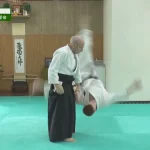[Monthly column] Worldwide Koryu Dojo Report Vol. 29 Shinto Muso-ryu in Ithaca, New York, USA
Interview and text by Grigoris Miliaresis
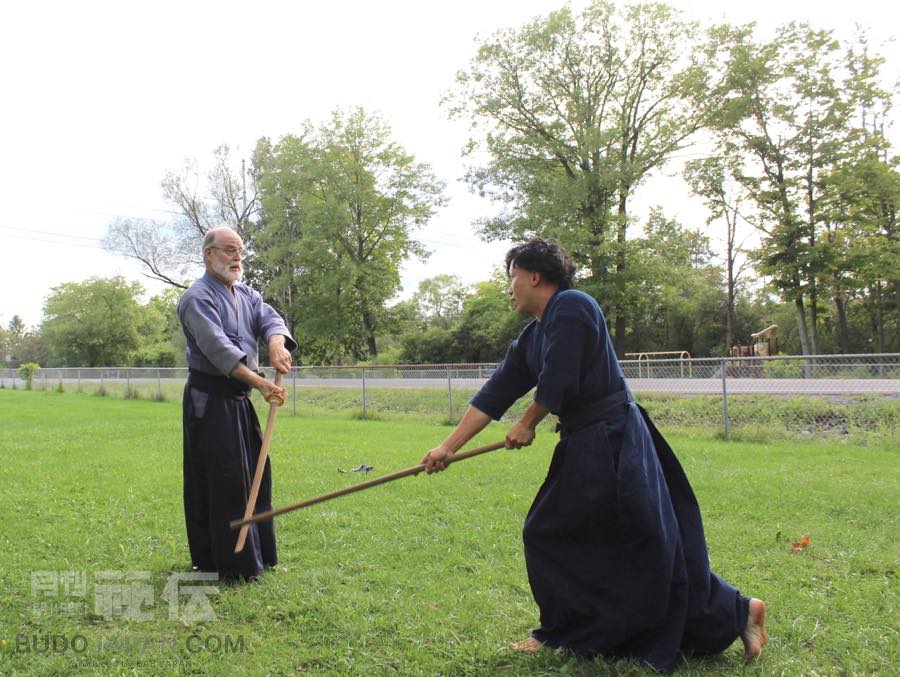
Finger Lake Koryu-kai regularly trains outdoors in good weather
In this 29th and penultimate edition, the Worldwide Koryu Dojo Report stays in the USA to record the journey and thoughts of one more member of Donn Draeger’s circle, Larry Biery of Ithaca, New York.
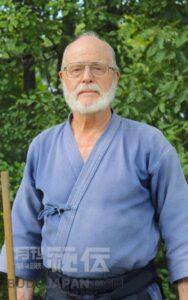
Finger Lakes Koryu-kai chief instructor Larry E. Bieri
Name: Shoshin Kan Dojo, Finger Lakes Koryu-kai
Location: Ithaca, New York, USA
Foundation year: 1993 Heartland Jodo-kai, Columbus, Ohio; 1997 Finger Lakes Koryu-kai, Ithaca, New York
Arts practiced: Shinto Muso-ryu Jo, Shinto-ryu Kenjutsu, Uchida-ryu Tanjo, Isshin-ryu Kusarigama, Ikkaku-ryu Jutte
Local affiliation: Finger Lakes Koryu-kai and Heartland Jodo-kai
Japan affiliation (instructor/organization): None
Instructor’s name: Larry E. Bieri
Instructor’s credentials/grades: Shinto Muso-ryu: Menkyo Kaiden; Aikikai Aikido: 7th dan shihan
Number of members: Ithaca Dojo 10
Members advanced/beginners ratio: 1/3
Days of practice/week: Sunday and Wednesday, 3 hours each
Website/social media/email: http://www.fingerlakeskoryu.org/ www.fingerlakesaikido.com/
toleb@aol.com
1) When and how did you get involved with the classical art(s) you practice?
In January, 1971, I got to Tokyo having had one aikido class and knowing nothing about the modern or classical arts. Thanks to Phil and Nobuko Relnick, I met some budo friends who found me an apartment near the Aikikai and introduced me to Donn F. Draeger. However when DFD said, “If you’re interested in the classical arts, let me know,” I had no idea what he meant; but I started aikido. This led to a visit to the Rembukan Dojo of Shimizu Takaji shihan with Meik Skoss early in 1974. There I met Draeger sensei again and have since been involved in various koryu bujutsu including Tendo-ryu, Toda-ha Buko-ryu, Honda-ryu Yumi and Tenshin Shoden Katori Shinto-ryu.
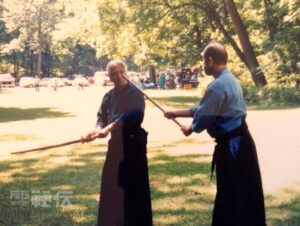
Larry E. Bieri in an early seminar with Nishioka Tsuneo at a state park in Ohio, USA (1998)
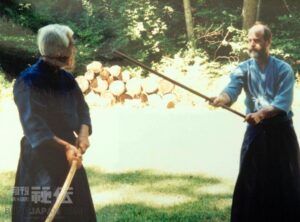
Larry E. Bieri and Nishioka Tsuneo in Ohio, USA (1998)
2) How widespread in your country are the classical martial art you practice and the classical arts in general?
I am currently active only in Shinto Muso-ryu Jo. SMR is practiced in quite a few places, with a small number of organizations centered on individual teachers. Kendo Seitei Jodo is practiced all over North America, but this is not koryu training and the two should be clearly separated. An emphasis on “style” and an aesthetically pleasing performance should not displace an investigation of the combat effectiveness of our movements. The kata we have inherited should be practiced in a way that develops the fitness, perceptive abilities, and reflexes necessary to survive a hostile encounter. Koryu in general are much more available now. Classical dojo in Japan have become more welcoming to non-Japanese since I left in 1987. We see many more non-Japanese from all over the world with legitimate classical training. Some of these practitioners are qualified and licensed to teach and open dojo at home. Others are not so adept and probably should not teach; but that is for the leaders of each lineage to decide. There is a surprising array of classical systems taught here.
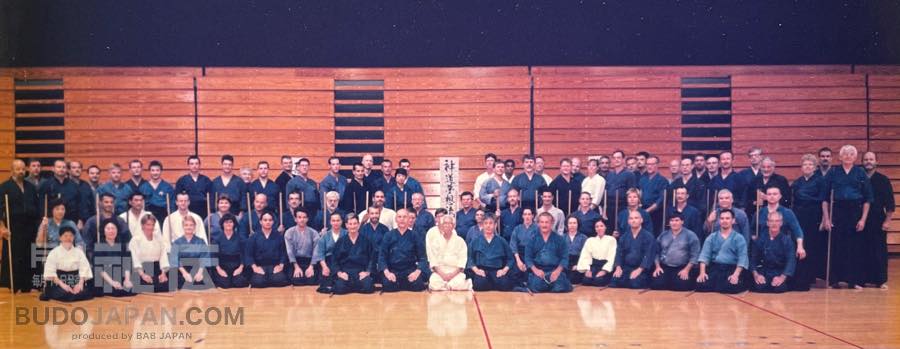
Jodo-ka from around the world attended “Gasshuku 2000,” sponsored by the International Jodo Federation (IJF). This IJF training camp was lead by Nishioka Tsuneo Shihan (seated, center). Other senior teachers seated in the front row are (from left) Quintin Chambers (UK & USA), Philip Relnick (USA), Shimizu Yuji (Japan), and Pascal Kreiger (Europe). The “Jamboree” custom was started by Donn F. Draeger as part of his efforts to spread Jodo internationally as requested by our teacher Shimizu Takaji Sensei, 25th soke of Shinto Muso-ryu Jo. The eighth such triennial event was organized by the Heartland Jodo-kai, an affiliation of Shinto Muso-ryu Jo dojo in the American Midwest under the direction of Larry E. Bieri.
3) Do you and the members of your group travel to Japan to practice?
Up to this time, we have not. Our group is disbursed around the Midwest of United States and it is difficult enough to organize a yearly schedule of seminars since travel distances are great. In addition, all of my direct Japanese teachers have now passed away. Officially, I remain a member of a few ryuha in Japan, but at this time I do not have contact with any particular dojo in Japan.
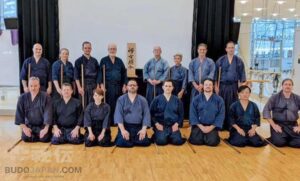
Spring Seminar participants at a rented venue near Ithaca
4) What is the biggest difficulty in practicing classical martial arts?
Finding dedicated students is a problem. The koryu seem arcane to most modern people, are difficult, and not as generally accessible as a gendai budo. Of course, this was part of the reason the modern budo were created in the first place 140 years ago, so it is hardly a new problem. Even Japanese don’t know what to look for in koryu. The need to be popular and attract a “clientele” may explain the surprising rise in the number of flamboyant “koryu” taught by rather young “masters” prominently displayed online.
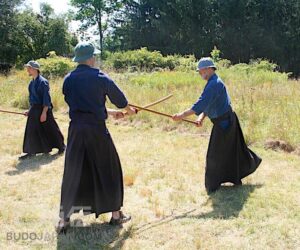
Seminar in Ithaca, NY USA; Shinto Muso-ryu Jo Omote training
5) What is the difference between practicing classical and modern Japanese martial arts?
The modern arts generally aim at societal improvement through individual self-improvement. They present a “life path” that includes socialization, moral discipline, exercise, conditioning, etc. Classical systems generally work to preserve a lineage or tradition for the sake of a family or location. Each ryuha maintains a different state of preservation in the face of centuries of societal evolution that has been working to make them obsolete. Ideally, as “fighting arts”, they somehow maintain a certain level of combat relevance despite these pressures, but some have moved towards an emphasis on aesthetics or even enlightenment, not unlike gendai budo.
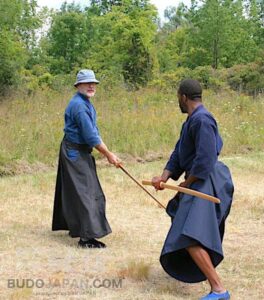
Seminar in Ithaca, NY; Shinto Muso-ryu Jo affiliated kenjutsu
6) What is your art’s strongest characteristic, historically or technically?
The most important aspect of SMR is the tremendous threat to the stick person posed by the bladed weapon. This relationship must inform every move in SMR, especially in regard to sen (initiative). Our teacher Nishioka Tsuneo sensei repeatedly emphasized how dangerous it is for the jo to move first. Technically speaking, it is essential to understand completely the difference between the Honte and the Gyakute grip. Nishioka sensei constantly emphasized this. The Honte grip is familiar to everyone with nihonto experience, so Gyakute is more interesting and complicated. I wonder if the main innovation in weapons usage discovered by SMR Founder Muso Gonnosuke may have been the use of the reverse grip in a way that is both effective and safe at the shorter maai of the jo when compared to the bo.
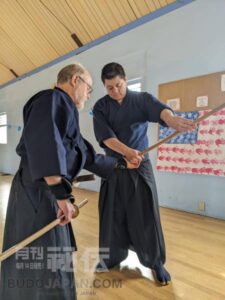
Instruction on te no uchi, gripping the jo
7) What is the benefit of practicing classical martial arts in the 21st century- especially for someone who isn’t Japanese?
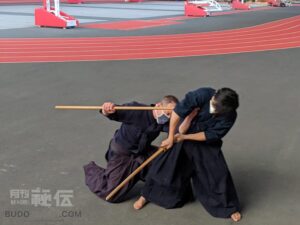
Shinto Muso-ryu Jo chudan training
There are the benefits of increased awareness and reflexes that many of your interviewees have mentioned, but these could be had through a modern budo, perhaps in a way more relevant to the times. Most people who stick with koryu training do so for the challenge, and for taking part in a living tradition through one’s group of trainees. These factors amplify the personal satisfaction and a sense of accomplishment in learning something as complex, time-consuming, and arcane as a koryu art.
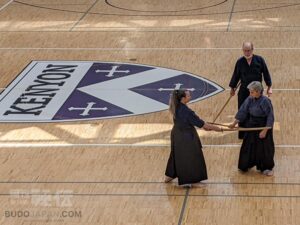
“JO in OH” Summer Seminar; held annually at Kenyon Collage, Ohio for over 20 years 2022 Summer Seminar; Shinto Muso-ryu Jo affiliated tanjo short stick training
8) Is there a Japanese community in your city? Do you have any connections to them and to other aspects of Japanese culture?
There are many Japanese at the two universities in Ithaca, but they rarely join any budo club. There is a Kendo club at Cornell University but we have little contact with them. We have participated in community and campus “Asian Art/Culture Festivals” by presenting koryu demonstrations. Interestingly, these events and activities have only rarely produced any response, and never an influx of new students. Of the few who have shown interest, only one was Japanese.
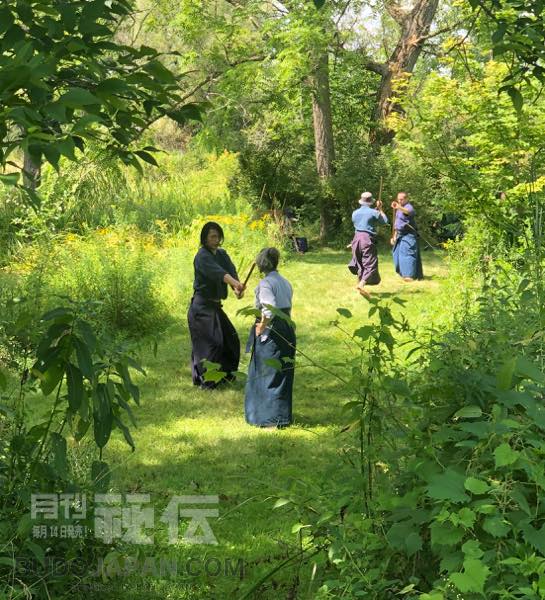
Finger Lake Koryu-kai students training Shinto Muso-ryu Jo in a park






